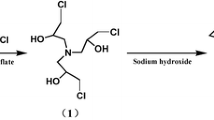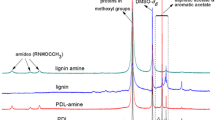Abstract
To guide the preparation of soy protein-based adhesives, the reaction between protein and formaldehyde as a possible cross-linker was studied in this paper under different pHs. To simplify the investigations, dipeptide N-(2)-l-alanyl-l-glutamine (AG) was used as a model compound for protein. Based on the analysis of the results of ESI-MS and 13C-NMR of the reaction products between AG and formaldehyde prepared under different pHs, it was found that the pH has strong effects on these reactions. Under strong acid conditions, such as pH 1–3, the methylolation reaction mainly occurred at the aliphatic amino groups of AG. However, it was very difficult for the resulted methylolated AG to be further condensed. Under weak acid conditions, such as pH 5, both the methylolation reaction between amido groups and formaldehyde and the further condensation reaction were possible. However, the condensation reaction was still rather weak under these conditions. At alkaline conditions, the methylolation reaction occurred between all of the three types of amino groups of AG and formaldehyde with both methylene bonds and methylene–ether bonds present in the system. Methylene bonds were mainly from the reaction between AG methylols and amido groups and aliphatic amino groups of AG. Ether bridges were formed between two methylolated AG mainly from amido groups.









Similar content being viewed by others

References
Bai W, Sheng Q, Nie F, Zheng J (2015) Controllable synthesis of formaldehyde modified manganese oxide based on gas-liquid interfacial reaction and its application of electrochemical sensing. ACS Appl Mater Interfaces 7(51):28377–28386
Cao M, Li T, Liang J, Du G (2016a) A 13C-NMR study on the 1,3-dimethylolurea-phenol co-condensation reaction: a model for amino-phenolic co-condensed resin synthesis. Polymers 8(11):391
Cao M, Li T, Wu Z, Liang J, Xie X, Du G (2016b) A computational study on the reaction mechanism of neutral phenol with formaldehyde in aqueous solution. Prog React Kinet Mech 41(2):144–152
Casanova M, Deyo DF, Heck HD (1989) Covalent binding of inhaled formaldehyde to DNA in the nasal mucosa of Fischer 344 rats: analysis of formaldehyde and DNA by high-performance liquid chromatography and provisional pharmacokinetic interpretation. Fundam Appl Toxicol 12(3):397–417
Casanova M, Morgan KT, Steinhagen WH, Everitt JI, Popp JA, Heck H (1991) Covalent binding of inhaled formaldehyde to DNA in the respiratory tract of Rhesus monkey: pharmacokinetics, rat-to-monkey interspecies scaling, and extrapolation to man. Fundam Appl Toxicol 17:403–428
Casanova M, Morgan KT, Gross EA, Moss OR, Heck H (1994) DNA- protein cross-links and cell replication at specific sites in the nose of F344 rats exposed subchronically to formaldehyde. Fundam Appl Toxicol 23:525–536
De Carvalho RA, Grosso CRF (2004) Characterization of gelatin based films modified with transglutaminase, glyoxal and formaldehyde. Food Hydrocolloids 18(5):717–726
Frihart CR, Satori H (2013) Soy flour dispersibility and performance as wood adhesive. J Adhes Sci Technol 27(18–19):2043–2052
Gao Q, Shi SQ, Zhang SF, Li J (2012) Soybean meal-based adhesive enhanced by MUF resin. J Appl Polym Sci 125(5):3676–3681
Ghahri S, Pizzi A (2018) Improving soy-based adhesives for wood particleboard by tannins addition. Wood Sci Technol 52(1):261–279
Ghahri S, Mohebby B, Pizzi A, Mirshokraie A, Mansouri HR (2017) Improving water resistance of soy-based adhesive by vegetable tannin. J Polym Environ 26(5):1881–1890. https://doi.org/10.1007/s10924-017-1090-6
Guo MR, Wang GR (2016) Milk protein polymer and its application in environmentally safe adhesives. Polymers 8(9):324
Jin CN, Zhang SC, Pang JY, Gao ZG (2014) Plywood with soy protein-acrylate hybrid adhesive. Adv Mater Res 884–885:108–111
Kumar R, Choudhary V, Mishra S, Varma IK, Mattiason B (2002) Adhesives and plastics based soy protein products. Ind Crops Prod 16:155–172
Lei H, Wu Z, Du G (2014) Cross-linked soy-based wood adhesives for plywood. Int J Adhes Adhes 50:199–203
Lei H, Wu ZG, Cao M, Du G (2016) Study on the soy protein-based wood adhesive modified by hydroxymethyl phenol. Polymers 8(7):256–265
Li C, Li H, Zhang S, Li J (2014a) Preparation of reinforced soy protein adhesive using silane coupling agent as an enhancer. BioResources 9(3):5448–5460
Li H, Li C, Gao Q, Zhang S, Li J (2014b) Properties of soybean-flour-based adhesives enhanced by attapulgite and glycerol polyglycidyl ether. Ind Crops Prod 59:35–40
Li J, Luo J, Li X, Yi Z, Gao Q, Li J (2015a) Soybean meal-based wood adhesive enhanced by ethylene glycol diglycidyl ether and diethylenetriamine. Ind Crops Prod 74:613–618
Li T, Guo X, Liang J, Wang H, Xie X, Du G (2015b) Competitive formation of the methylene and methylene ether bridges in the urea-formaldehyde reaction in alkaline solution: a combined experimental and theoretical study. Wood Sci Technol 49:475–493
Li T, Cao M, Liang J, Xie X, Du G (2017) New mechanism proposed for the base-catalyzed urea-formaldehyde condensation reactions: a theoretical study. Polymers 9(6):203
Li T, Cao M, Zhang B, Yang L, Du G (2018) Effects of molar ratio and pH on the condensed structures of melamine-formaldehyde polymers. Materials 11(12):2571
Liang J, Wu Z, Lei H, Xi X, Li T, Du G (2017) The reaction between furfuryl alcohol and model compound of protein. Polymers 9(12):711
Liang J, Li T, Cao M, Du G (2018) Urea-formaldehyde resin structure formation under alkaline condition: a quantitative 13C-NMR study. J Adhes Sci Technol 32(4):439–447
Nishinaria K, Fang Y, Guo S, Phillips GO (2014) Soy proteins: a review on composition, aggregation and emulsification. Food Hydrocolloids 39:301–318
Peng GY, Zhao W, Lu ZS, Liu YS, Xu Y (2006) Study on the repair of DNA-protein crosslinks induced by formaldehyde. Asian J Ecotoxicol 1(2):144–149
Pizzi A (1977) Chemistry and technology of cold and thermosetting wattle tannin based wood adhesives. Thesis. University of the Orange Free State
Pizzi A (2006) Recent developments in eco-efficent bio-based adhesives for wood bonding. Oppor Issues 20(8):829–846
Pizzi A, Tondi G, Pasch H, Celzard A (2008) MALDI-TOF structure determination of complex thermoset networks-polyflavonoid tannin-furanic rigid foams. J Appl Polym Sci 110(3):1451–1456
Qu P, Huang H, Wu G, Sun E, Chang Z (2015) Hydrolyzed soy protein isolates modified urea–formaldehyde resins as adhesives and its biodegradability. J Adhes Sci Technol 29(21):2381–2398
Trischler J, Sandberg D (2015) Wheat protein as adhesive for wood products for interior use. Pro Ligno 11(4):246–252
Vnučec D, Goršek A, Kutnar A, Mikuljan M (2015) Thermal modification of soy proteins in the vacuum chamber and wood adhesion. Wood Sci Technol 49(2):225–239
Vnučec D, Kutnar A, Goršek A (2016) Soy-based adhesives for wood-bonding—a review. J Adhes Sci Technol 31(8):910–931
Wu Z, Lei H, Du G (2013) Disruption of soy-based adhesive treated by Ca(OH)2 and NaOH. J Adhes Sci Technol 27(20):1–7
Xu Y, Liu L (2016) Structural and functional properties of soy protein isolates modified by soy soluble polysaccharides. J Agric Food Chem 64(38):7275–7284
Xu F, Dong Y, Zhang W, Zhang S, Li L, Li J (2015) Preparation of cross-linked soy protein isolate-based environmentally-friendly films enhanced by PTGE and PAM. Ind Crops Prod 67:373–380
Yang I, Kuo ML, Deland JM (2013) Bond quality of soy-based phenolic adhesives in southern pine plywood. J Am Oil Chem Soc 83(3):213–237
Zhang S, Dong L, Pang J, Sun C (2010) The research of modified-soy-protein–acrylate hybrid emulsion. Adv Mater Res 113–116:1818–1823
Zhang J, Tian Y, Cui Y, Zuo W, Tan T (2013) Key intermediates in nitrogen transformation during microwave pyrolysis of sewage sludge: a protein model compound study. Biores Technol 132:57–63
Acknowledgements
This work was supported by National Natural Science Foundation of China (Nos. 31660176 and 31800481), Science-technology Support Foundation of Guizhou Province of China (Nos. [2019]2325 and [2019]2308), Education Department Foundation of Guizhou Province of China (No. [2017]114).
Author information
Authors and Affiliations
Corresponding authors
Ethics declarations
Conflict of interest
The authors declare that they have no conflict of interest.
Additional information
Publisher's Note
Springer Nature remains neutral with regard to jurisdictional claims in published maps and institutional affiliations.
Rights and permissions
About this article
Cite this article
Liang, J., Wu, Z., Xi, X. et al. Investigation of the reaction between a soy-based protein model compound and formaldehyde. Wood Sci Technol 53, 1061–1077 (2019). https://doi.org/10.1007/s00226-019-01118-8
Received:
Published:
Issue Date:
DOI: https://doi.org/10.1007/s00226-019-01118-8



